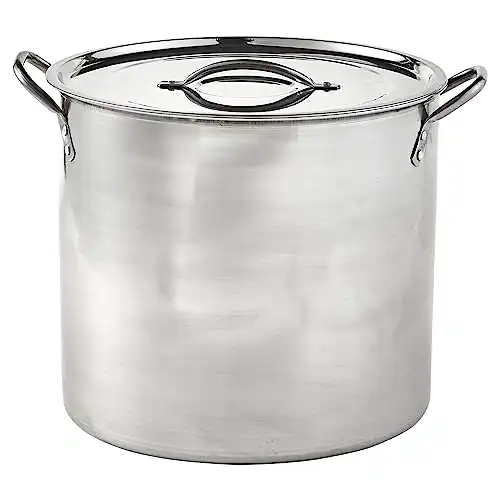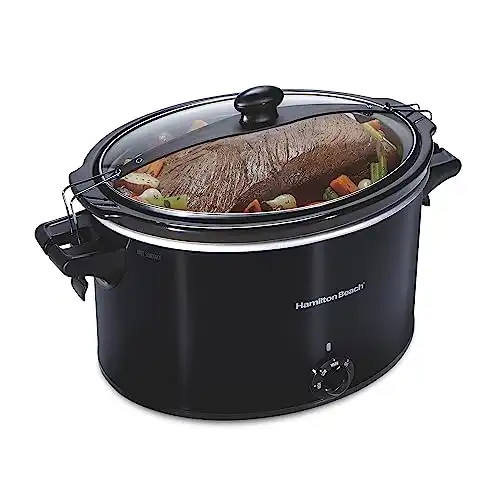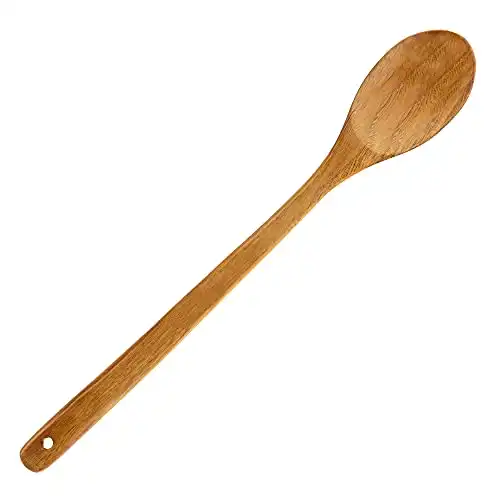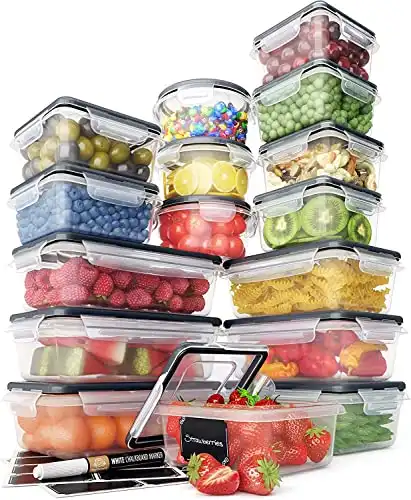5 Paleo Batch Cooking Tips to Save Time and Eat Better
Paleo batch cooking saves time & ensures healthy meals for beginners. Plan balanced meals, use proper tools, & follow a step-by-step process for efficient cooking.

While I was working in professional kitchens, batch cooking was a necessity. But after I hung up my apron, I learned that the same principles of batch cooking could be used to make my home cooking time more efficient and more enjoyable. So today, I’d like to put my experience in commercial kitchens to use in teaching you how paleo batch cooking is the perfect way for beginners to save time and eat better!
Whether your inner caveman (or cavewoman) loves cooking or doesn’t feel comfortable with it at all, this guide will teach you everything you need to know to set yourself up for weekly mealtime success. I’ll be covering the basics of batch cooking, including what tools you should have before you start, and then giving you a foolproof step-by-step process for paleo batch cooking. Then, we’ll round it all out with a handful of sample recipes to make your meal prep fun, interesting, and easy.
Disclosure: As an Amazon Associate, this site earns from qualifying purchases. Thank you!
The Basics of Batch Cooking
Once you get the hang of it, batch cooking can be a huge time saver. With just a few hours of cooking on the weekend, you can make meals that will last you through the entire week.
To get the most out of batch cooking, though, you’ll need to keep two things in mind:
- First, batch cooking is best when you cook things that won’t lose nutrition as they sit, and won’t have an unpleasant texture after being refrigerated. This means that your paleo batch cooking will focus mainly on meat and non-starchy vegetables (like broccoli and cauliflower). For starchy vegetables, sweet potatoes keep their texture, taste, and nutrition better than russet potatoes.
- Second, you’ll need to do a fair bit of planning. Plan for complete, balanced meals for however many days ahead you want. Beginners will want to start with six days’ worth of each food, to have a meal ready to eat every day of the week before their next batch cooking day.
What is a balanced batch-cooked meal for paleo, though? It has three main parts: Protein (meat or eggs), fat (olive oil or the fat found naturally in meat), and non-starchy vegetables. With something as simple as cooked chicken, a drizzle of olive oil, and sautéed broccoli, you can have complete nutrition ready in a matter of minutes.
Whether you choose to cook these pieces individually and mix and match them for meals, or cook them all together for quick grab-and-go meals, is up to you.
Tools for Paleo Batch Cooking
Depending on how well-stocked your kitchen is, you may need to pick up a few specialized tools to make paleo batch cooking accessible. Having a large stock pot will let you cook big quantities of food without fear of spilling over the sides of your pan.
In a similar vein, a slow cooker like a CrockPot makes it easy to prepare slow-simmered meals with minimal hands-on effort.
Pair these with a few long-handled wooden spoons and you’ll have everything you need to get started on paleo batch cooking.
You’ll need a good selection of storage containers, too. Wherever possible, avoid plastic and go for wooden or glass containers instead – or dedicated meat storage containers. We like choosing a variety of sizes and shapes to accommodate meals and snacks. A few small containers will let you store oil, sauces, or salad dressings separately from your cooked foods, keeping everything as fresh as possible.
How To Efficiently Batch Cook for a Paleo Diet
Set aside about two or three hours the first time you’re batch cooking for the week ahead. Once you’re familiar with the steps below, it may go by faster, but it’s better to be safe than sorry!
- Preheat your oven to 350 degrees. Do other miscellaneous prep (like grabbing cutting boards, any carving knives, etc).
- Get your proteins & vegetables cooking. Arrange your protein and root vegetables on a baking tray, drizzled with olive oil, and seasoned with salt and pepper. Set a timer for 50 minutes.
- Prep your fresh greens. Wash, chop, and store your fresh greens for salads. Prepare any dressings you’d like, and store them separately from your greens.
- Take vegetables out and increase oven temperature. Take your proteins and vegetables out of the oven when they’re finished, then increase the temperature to 450 degrees.
- Prep & Cook Your Sweet Potatoes. Chop sweet potatoes into 1-inch cubes, toss them in oil, salt, and pepper, and arrange them in one layer on a sheet pan. Put it in the oven for 30-40 minutes.
- Store Your Proteins. Once the proteins have cooled to around room temperature, store them with the roasted vegetables. Repeat with sweet potatoes, once they’re finished cooking.
- That’s it! Enjoy! Follow those steps, and you’ll have many meals worth of food ready to go.
This method works wonderfully for the mix-and-match style of paleo batch cooking. Alternatively, you can cook large batches of complete meals like chili, curries, and casseroles — which we’ll cover in the next section.
Sample Paleo Batch Cooking Recipes
If you’re looking to cut down on your kitchen prep time, making large batches of a single dish to eat throughout the week is a good way to go. Try to make at least two different meals, though, or else you’ll probably get pretty bored with what you’re eating by the end of the week.
Here are a few paleo batch cooking ideas to get you started:
- Paleo Chili leaves out the beans, focusing instead on hearty portions of beef and root vegetables. Start with a base of onions and garlic sautéed in olive oil, add beef, and cook until browned, then add small-chopped vegetables like carrots, bell peppers, and parsnips. Finish with tomatoes, tomato juice, and chili powder, then add salt to taste. This one’s especially easy to make in a slow cooker — just brown the onions, garlic, and beef in a separate pan, and then combine everything else in the slow cooker.
- Sausage and Sweet Potato Hash can be made ahead of time in a large pot, then easily reheated as a savory and healthy breakfast option (it’s a great breakfast meat alternative) all week long. Peel your sweet potatoes first, then grate them on the coarse side of a box grater. Crumble sausage and cook in oil until golden brown. Then, add the grated sweet potatoes, salt, pepper, and dried herbs. Mix with the sausage and oil, then spread flat to cook on one side for 10-12 minutes. Flip over and repeat on the other side, and then you’re finished!
- Chicken Broccoli Casserole, or really any casserole, is a super-easy make-ahead meal for paleo diets. Combine cooked, shredded chicken, broccoli florets, and mushrooms with olive oil, chicken broth, cashew milk, salt, and pepper. Bake in an oven at 350 degrees for 30-40 minutes, and you’re set with a nutritious meal. Try switching out the chicken for other proteins, or adding any sort of fresh vegetables you have around the house — casseroles are a versatile recipe that can be infinitely adapted.
Frequently Asked Questions
How do you shop on the paleo diet?
When you’re on the paleo diet, it’s important to shop smart. The best way to do this is by sticking to the outside aisles of the grocery store. These are the aisles where you’ll find fresh produce, meat, and seafood. By avoiding the inner aisles, you’ll stay away from all of the processed foods that are harmful to your health on the paleo diet.
What makes something paleo?
The Paleo diet is based on the idea that if our ancestors didn’t eat it, we shouldn’t either. That means following a diet of natural, unprocessed foods and avoiding anything that has been altered or made in a factory. So anything that is grain-based, dairy-based, legume-based or processed is out. But there are plenty of delicious options to choose from including meat, fish, poultry, eggs, fruits, vegetables and healthy fats like olive oil and coconut oil.
Is paleo diet good for weight loss?
The paleo diet is great for weight loss because it focuses on eating whole, unprocessed foods that are low in carbohydrates and high in protein and healthy fats. This combination helps to boost metabolism and burn calories, leading to weight loss.
What is batch preparation in cooking?
Batch preparation (or batch cooking) is the process of cooking a large amount of food, all at once, so that you have multiple meals that can be eaten throughout the week. This can be done with a variety of different dishes but is especially useful for foods that can be stored in the fridge or freezer. By batch cooking, you’ll save both time and money, and your meals will always be healthy and delicious.
What are the benefits of batch cooking?
The benefits of batch cooking are that you can save time and money. When you cook in bulk, you can prepare a lot of food at once and then freeze it or eat it throughout the week. This way, you don’t have to spend as much time in the kitchen preparing meals, and you’ll also save money on groceries.
Is it cheaper to batch cook?
Yes! Making a big batch of food is a great way to save money. Also, remember that the cost per serving now changes depending on the size of your family. This means that those meals will now last much longer and you can eat from that batch as you need it because it’s already there.
What should I pack for lunch on Paleo diet?
You should pack a portion of protein such as meat, poultry, fish, seafood, eggs, nuts, seeds, or breakfast sausage for lunch on the Paleo diet. Additionally, include plenty of vegetables, including starchy options and/or fruit. Don’t forget to include healthy fats like salad dressing with oil, nut butter, eggs, oily fish, nuts, seeds, or avocado in your lunch.
What are red flags of the paleo diet?
Red flags of the paleo diet include the potential risk of ketosis, which is the excessive use of fat for energy. Ketosis happens when ketones, by-products of fat breakdown, accumulate in the blood. The presence of high levels of ketones can result in dehydration and, in severe cases, coma due to significant metabolic abnormalities.
What are the taboos of the paleo diet?
The taboos of the paleo diet include allowing certain foods that were not available during that era, such as low-fat dairy products and potatoes, in relaxed versions of the diet. However, some variations of the diet completely avoid fruits and vegetables that are considered to contain excessive amounts of fructose.
Is it OK to have a cheat day on paleo?
It is not acceptable to have a cheat day on the Paleo diet as it eliminates entire food groups and does not allow for any breaks from the diet plan. However, regardless of the diet plan followed, it is important to incorporate enjoyable meals to make the diet plan sustainable.
Is paleo considered anti-inflammatory?
The paleo diet is considered to have anti-inflammatory properties, although it works differently compared to the keto diet in terms of managing inflammation and related health conditions. While the paleo diet is more effective in managing autoimmune diseases, the keto diet is more beneficial for managing diabetes and metabolic syndrome.
Why am I not hungry on paleo diet?
You are not hungry on the paleo diet because the modern paleo diet is more effective in regulating appetite. The insoluble fibers found in the grasses consumed by our ancestors are not easily broken down by the body, which means they may not stimulate the same appetite-suppressing signals as other types of fiber.
Can you eat rice on paleo?
Rice can be consumed on the paleo diet, as it is a grain that does not contain gluten. However, it is important to note that while some individuals may be able to process rice without any problems, others may have issues with it.
How do you eat Paleo on a budget?
To eat Paleo on a budget, one can save money by purchasing seasonal produce and conducting planning and research to identify which Paleo-friendly items are available during different times of the year. Another option is to grow your produce, which can be cost-effective. Additionally, opting for less expensive cuts of meat can help reduce expenses. Buying groceries in bulk is another strategy to save money, and planning ahead of time can also contribute to a budget-friendly Paleo diet.
What are the weaknesses of the paleo diet?
The weaknesses of the paleo diet include potential low energy levels and feelings of tiredness due to its restrictive nature, which may not provide sufficient calories or essential nutrients like carbohydrates. Fatigue can be attributed to the limited intake of carbs, which is a significant factor.
How many times a day do you eat on paleo?
The recommended frequency of meals on the paleo diet is typically three times a day. However, if hunger strikes in between meals, there are convenient and paleo-friendly snack options available such as baby carrots, hard-boiled eggs, and a piece of fruit.
What do you eat on the 30 day paleo diet?
The 30-day paleo diet consists of consuming meat, fish, eggs, vegetables, fruits, nuts, seeds, herbs, spices, healthy fats, and oils. It is important to avoid processed foods, sugar, soft drinks, artificial sweeteners, and trans fats. Additionally, it is recommended to limit the intake of grains, dairy products, and legumes.
Why is the paleo diet expensive?
The paleo diet is not necessarily expensive, as it primarily focuses on consuming essential foods such as healthy fats and oils, vegetables, and fruits. Contrary to the misconception that it is a costly diet, the paleo lifestyle emphasizes basic, nutritious ingredients without the need for extravagant or fancy options.
How do you eat Paleo while camping?
To eat Paleo while camping, one can enjoy protein-rich eggs that are easily prepared in a skillet. Additionally, stable meats such as hard salami, dry salami, bacon, jerky, and canned tuna/salmon serve as convenient options for quick lunches when a full meal is not desired.
Can you overeat on paleo?
You can overeat on paleo by consuming excessive amounts of certain foods like fruit, potatoes and sweet potatoes, nuts, and seeds, even though they are considered paleo-friendly. To prevent this, it is advisable to restrict the intake of these foods to mealtime.
What are the dos and don’ts of starting a paleo diet?
The dos and don’ts of starting a paleo diet include incorporating meat, fish, eggs, vegetables, fruits, nuts, seeds, herbs, spices, healthy fats, and oils into your meal plan. It is important to avoid processed foods, sugar, soft drinks, artificial sweeteners, and trans fats. Additionally, it is recommended to limit the consumption of grains, dairy products, and legumes.
How to eat paleo without meat?
To eat paleo without meat, one can incorporate a variety of plant-based options into their diet. These include fruits, vegetables, nuts, and seeds. Additionally, cage-free eggs can be included as a source of protein. Unrefined added fats, such as olive oil and coconut oil, can also be used to enhance flavor and provide necessary nutrients.
How many days can I batch cook for?
You can safely batch-cook meals for up to seven days as long as they are cooked properly. However, it is important to note that by day five, the taste might not be as enjoyable. To summarize, most meals can be stored in the fridge for up to four days while remaining both safe and tasty.
How to batch cook for a week?
To batch cook for a week, a practical approach is to create a versatile base recipe that can be transformed into various dishes. Rather than consuming identical meals throughout the week, you can divide the base into portions, freeze them, and later defrost and utilize them in different dishes.
How long does batch cooking last in the fridge?
Batch cooking can last in the fridge for up to 48 hours, but it is advisable to freeze them right away to avoid forgetting about them. Frozen leftovers should be consumed within 3-6 months for optimal taste, but they can still be safely eaten for a longer period as long as they are cooled and reheated thoroughly.
Does batch cooking save money?
Batch cooking does save money because it involves preparing large amounts of food in advance and storing them in smaller portions for future consumption. This method not only helps to streamline the meal preparation process but also reduces the overall cost of groceries as buying ingredients in bulk tends to be more cost-effective.
Is batch cooking worth it?
Batch cooking is worth it as it enables you to improve your eating habits, reduce the time spent on daily cooking, and cut down on overall food expenses. While it may initially seem challenging to start your batch cooking journey, once you become accustomed to it, you’ll discover how much it simplifies your life.
Is batch cooking and freezing healthy?
Batch cooking and freezing is a healthy way to enjoy delicious home-cooked food that is also convenient, time-saving, and cost-effective. By cooking larger quantities of meals and freezing them in separate portions, you can have ready-made meals for later. Additionally, buying ingredients in bulk can help save money.
What do I need to start batch cooking?
To start batch cooking, all you need are large pans to ensure the recipe you plan to cook will fit into the available pans. While some individuals find slow cookers and soup makers helpful for preparing multiple meals at once, they are not necessary equipment for batch cooking.
Why batch cooking is better than meal prep?
Batch cooking is better than meal prep because it allows you to cook all the meals at once and store them in the refrigerator. This means that you can easily multitask by simmering a large pot of curry while attending to other chores. Additionally, when it’s time to eat, all you have to do is heat up the food and serve it. As a result, batch cooking saves you a significant amount of time and energy compared to meal prep.










